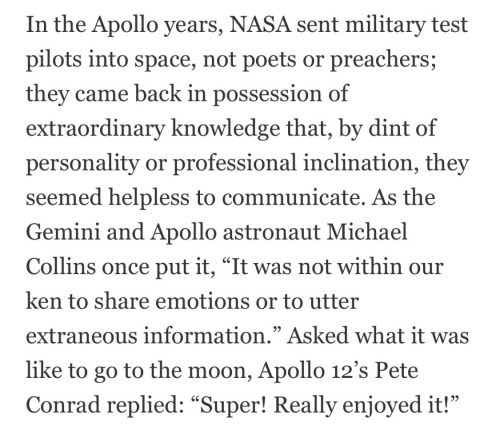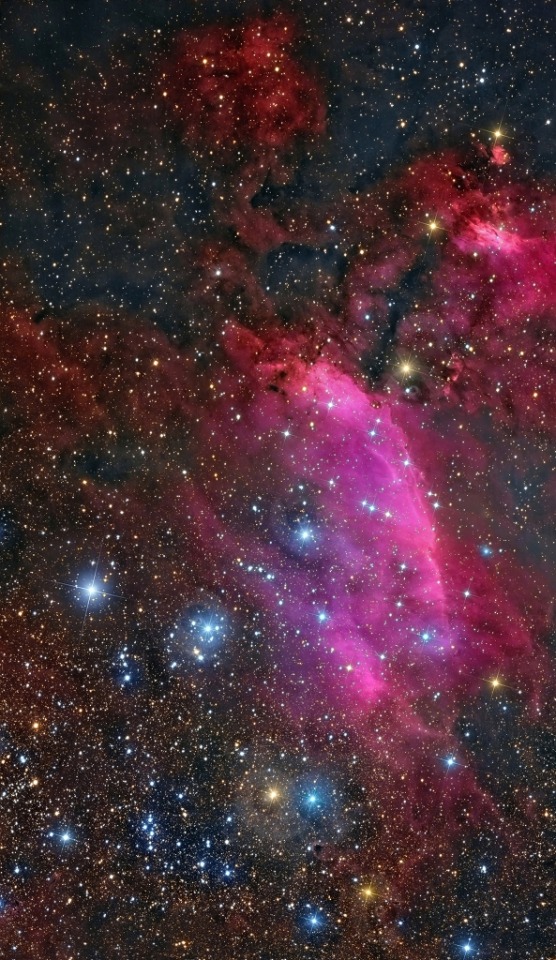Into The Cosmic Heart, IC 1850 © Aleix Roig

Into the Cosmic Heart, IC 1850 © Aleix Roig
More Posts from Ad-astra-affecte-spe and Others

Andromeda over the Swiss Alps Image Credit: Dzmitry Kananovich
Y'all, the world is sleeping on what NASA just pulled off with Voyager 1
The probe has been sending gibberish science data back to Earth, and scientists feared it was just the probe finally dying. You know, after working for 50 GODDAMN YEARS and LEAVING THE GODDAMN SOLAR SYSTEM and STILL CHURNING OUT GODDAMN DATA.
So they analyzed the gibberish and realized that in it was a total readout of EVERYTHING ON THE PROBE. Data, the programming, hardware specs and status, everything. They realized that one of the chips was malfunctioning.
So what do you do when your probe is 22 Billion km away and needs a fix? Why, you just REPROGRAM THAT ENTIRE GODDAMN THING. Told it to avoid the bad chip, store the data elsewhere.
Sent the new code on April 18th. Got a response on April 20th - yeah, it's so far away that it took that long just to transmit.
And the probe is working again.
From a programmer's perspective, that may be the most fucking impressive thing I have ever heard.

Boo! Did we get you? 🎃
This solar jack-o-lantern, captured by our Solar Dynamics Observatory (SDO) in October 2014, gets its ghoulish grin from active regions on the Sun, which emit more light and energy than the surrounding dark areas. Active regions are markers of an intense and complex set of magnetic fields hovering in the sun’s atmosphere.
The SDO has kept an unblinking eye on the Sun since 2010, recording phenomena like solar flares and coronal loops. It measures the Sun’s interior, atmosphere, magnetic field, and energy output, helping us understand our nearest star.
Grab the high-resolution version here.
Make sure to follow us on Tumblr for your regular dose of space!

NASA Hubble Space Telescope - The ‘Swan Nebula’
HOW DO ASTRONOMERS DETECT EXOPLANETS AND DETERMINE IF THEY COULD SUPPORT LIFE??
Blog#335
Wednesday, September 27th, 2023
Welcome back,
On March 21, NASA announced the confirmation of the 5,000th planet outside our Solar System. From scorching-hot gas giants nestled near their parent star to rocky worlds that may host water on their surface, there’s a variety for scientists to study.
But finding these strange new worlds is a science in itself.

We’ve only been able to definitively detect planets of any kind for a few decades, and even at that, there are challenges in detecting such a small object at that distance in even the most powerful telescopes.
Inverse spoke with Marie-Eve Naud, an exoplanet researcher and outreach coordinator for the University of Montreal’s Institute for Research on Exoplanets, to tell us more about how astronomers find these worlds and the considerations for each method.

While there are numerous methods, the ones cited below are the most common.
THE TRANSIT METHOD
Astronomers have discovered most exoplanets using the transit method, notably with NASA's Kepler telescope launched in 2009. This method observes planets as they pass in front of their stars, causing a slight dimming of starlight, which photometers can detect. This approach works best in space due to minimal atmospheric interference, favored by missions like ESA's Cheops and NASA's TESS.

To confirm exoplanets, multiple transits are necessary to rule out sunspots or dust as causes of light fluctuations. Typically, two or three transits are required to gather substantial data.
Once a planet is detected, astronomers can estimate its radius, while mass is often determined through the radial velocity method. The combination of mass and radius helps classify a planet as rocky or gaseous, impacting its potential habitability.

Factors like proximity to an active star and radiation levels also affect habitability assessments, as seen with TRAPPIST-1's uncertain habitability despite hosting seven Earth-sized planets in its habitable zone.
RADIAL-VELOCITY METHOD
The radial velocity method is commonly used to discover planets, particularly with instruments like HARPS at the European Southern Observatory’s La Silla 3.6m telescope in Chile.

Planets and stars both orbit around their center of mass. A star with a planet exhibits a slight motion. Multiple planets can lead to complex motions.
This method involves analyzing the star's spectrum. When the star approaches, its light shifts towards red due to compression. When it moves away, the light shifts towards blue.

The planet's motion slightly affects the star's spectrum, creating a "barcode" of the star.
The first detection of a planet around a Sun-like star using this method was in 1995 when Didier Queloz and Michel Mayor found 51 Pegasi b. Prior to that, in 1992, planets were detected around pulsar PSR B1257+12, using changes in the pulsar's radio signal. This showcases the diverse scientific approaches to discovering distant worlds.
Originally published on www.inverse.com
COMING UP!!
(Saturday, September 30th, 2023)
"WHAT IS THE BLOCK THEORY??"
-
 fight-my-fury liked this · 3 months ago
fight-my-fury liked this · 3 months ago -
 demiaries reblogged this · 6 months ago
demiaries reblogged this · 6 months ago -
 silvereyedowl reblogged this · 8 months ago
silvereyedowl reblogged this · 8 months ago -
 avadanielsgf reblogged this · 9 months ago
avadanielsgf reblogged this · 9 months ago -
 avadanielsgf liked this · 9 months ago
avadanielsgf liked this · 9 months ago -
 blueskies-keepraining reblogged this · 9 months ago
blueskies-keepraining reblogged this · 9 months ago -
 onefleshonepod reblogged this · 9 months ago
onefleshonepod reblogged this · 9 months ago -
 lioness-of-the-north liked this · 9 months ago
lioness-of-the-north liked this · 9 months ago -
 merzbuilds liked this · 10 months ago
merzbuilds liked this · 10 months ago -
 john-erby liked this · 10 months ago
john-erby liked this · 10 months ago -
 shelxyzm liked this · 10 months ago
shelxyzm liked this · 10 months ago -
 unlikelypersonalknight1 liked this · 10 months ago
unlikelypersonalknight1 liked this · 10 months ago -
 k-llewellin-novelist reblogged this · 10 months ago
k-llewellin-novelist reblogged this · 10 months ago -
 dreamskinny17 liked this · 11 months ago
dreamskinny17 liked this · 11 months ago -
 cold-heart-legacy reblogged this · 1 year ago
cold-heart-legacy reblogged this · 1 year ago -
 luminary-phantom reblogged this · 1 year ago
luminary-phantom reblogged this · 1 year ago -
 sunshine6ixty liked this · 1 year ago
sunshine6ixty liked this · 1 year ago -
 our-love-will-destroy-the-world liked this · 1 year ago
our-love-will-destroy-the-world liked this · 1 year ago -
 furryjazzbat liked this · 1 year ago
furryjazzbat liked this · 1 year ago -
 evilveva liked this · 1 year ago
evilveva liked this · 1 year ago -
 the-riff-compels-me liked this · 1 year ago
the-riff-compels-me liked this · 1 year ago -
 seima-tenshi liked this · 1 year ago
seima-tenshi liked this · 1 year ago -
 herdarkangel liked this · 1 year ago
herdarkangel liked this · 1 year ago -
 n-yctophilie reblogged this · 1 year ago
n-yctophilie reblogged this · 1 year ago -
 n-yctophilie liked this · 1 year ago
n-yctophilie liked this · 1 year ago -
 seasons-in-hell reblogged this · 1 year ago
seasons-in-hell reblogged this · 1 year ago -
 seasons-in-hell liked this · 1 year ago
seasons-in-hell liked this · 1 year ago -
 themadhatersteaparty liked this · 1 year ago
themadhatersteaparty liked this · 1 year ago -
 shannybangbang reblogged this · 1 year ago
shannybangbang reblogged this · 1 year ago -
 bumkeyz reblogged this · 1 year ago
bumkeyz reblogged this · 1 year ago -
 oh-nostalgiaa liked this · 1 year ago
oh-nostalgiaa liked this · 1 year ago -
 jellisdraws liked this · 1 year ago
jellisdraws liked this · 1 year ago -
 captastra reblogged this · 1 year ago
captastra reblogged this · 1 year ago -
 sergej963 liked this · 1 year ago
sergej963 liked this · 1 year ago -
 trucker387 liked this · 1 year ago
trucker387 liked this · 1 year ago -
 transcendinfinity7 liked this · 1 year ago
transcendinfinity7 liked this · 1 year ago -
 deepthinker1995 liked this · 1 year ago
deepthinker1995 liked this · 1 year ago -
 sdaywithme6 liked this · 1 year ago
sdaywithme6 liked this · 1 year ago -
 thunderapache-blog reblogged this · 1 year ago
thunderapache-blog reblogged this · 1 year ago -
 themaliciousravioli reblogged this · 1 year ago
themaliciousravioli reblogged this · 1 year ago -
 themaliciousravioli liked this · 1 year ago
themaliciousravioli liked this · 1 year ago -
 balance0101 liked this · 1 year ago
balance0101 liked this · 1 year ago -
 vihubehe liked this · 1 year ago
vihubehe liked this · 1 year ago -
 soongtypehuman liked this · 1 year ago
soongtypehuman liked this · 1 year ago -
 mythiious liked this · 1 year ago
mythiious liked this · 1 year ago -
 furiousbreadgoatee liked this · 1 year ago
furiousbreadgoatee liked this · 1 year ago

★•Astronomy, Physics, and Aerospace•★ Original and Reblogged Content curated by a NASA Solar System Ambassador
204 posts



